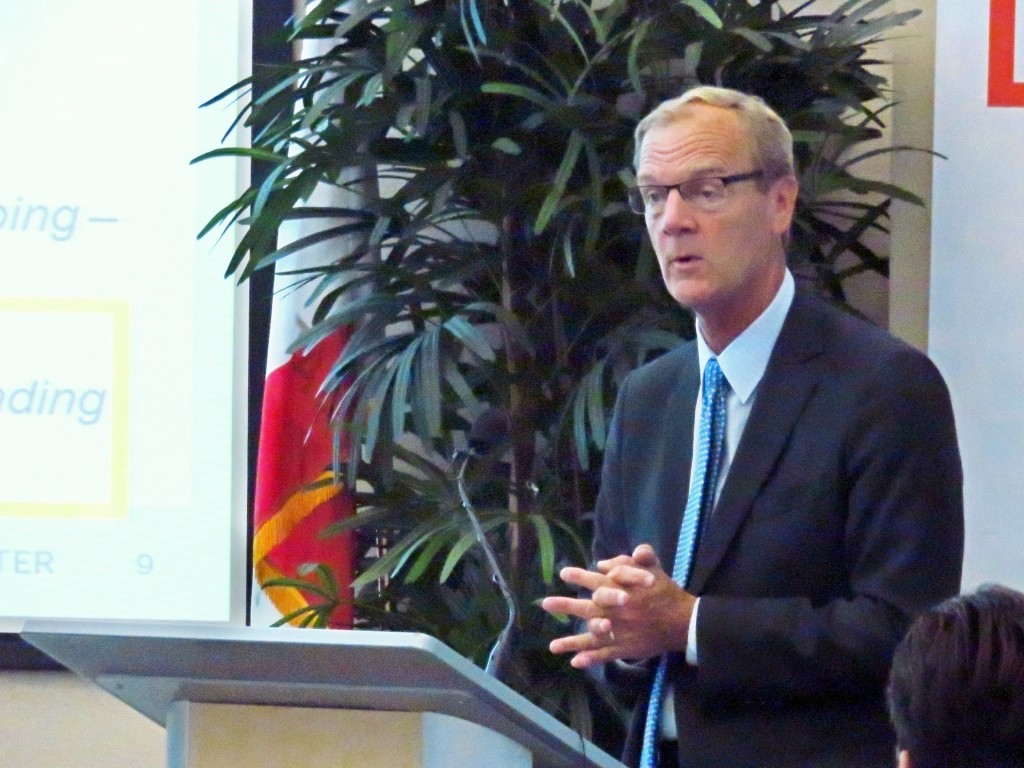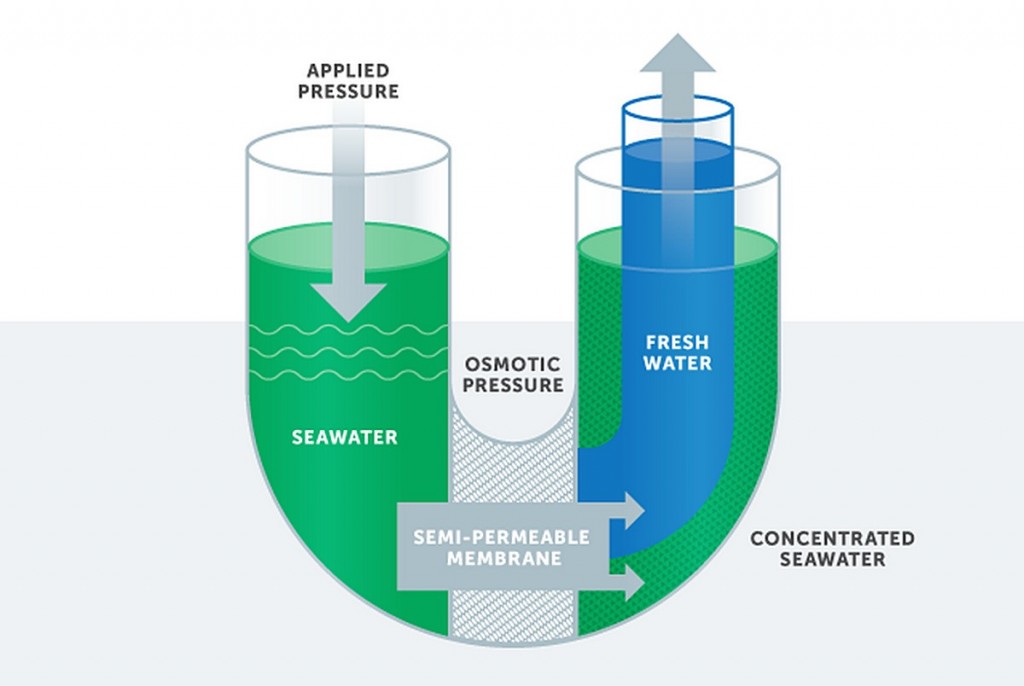
— Photo by Sara Hall ©
Newport Beach woke up to a discussion of desalination at a meeting this week.
About 50 people attended the Newport Beach Chamber of Commerce’s monthly Wake Up! Newport on Thursday in the Friend’s Room at the library.
The July topic was “Desalination… Answer to the Drought?” The guest speaker was Poseidon Water LLC Executive Vice President Andrew Kingman.
Kingman spoke about the desalination plant proposed in Huntington Beach, and the plant currently being built in Carlsbad, environmental effects, the Orange County Water District, how desalination will affect Newport Beach, the next steps, and more.
Desalination is not only to the removal of salt from seawater, it actually removes virtually any mineral and most biological and organic chemical compounds to produce quality water suitable for drinking, according to Poseidon.
“Under natural conditions, osmotic pressure would drive seawater with a lower concentration of dissolved salt though a separation membrane toward water with a higher concentration of salt,” Poseidon explains on their website. “In the reverse osmosis process, with pressure from large pumps, we overcome the natural osmotic pressure and reverse the movement of water by driving the water through RO membranes. The process removes salt and creates fresh water, while the remaining salt and water is returned to the ocean as concentrated seawater.”
In order to remove the salt, the water is forced through membranes at a pressure of 800 pounds per square inch, Kingman explained.
To make a reverse osmosis system work, it needs to bring in about twice as much salty sea water than the amount of fresh water that is wanted to produce, he said.
The ocean has about 3.5 percent salt, Kingman noted. So if 100 million gallons are brought in every day, which is about how much is needed to make the 50 million gallons of fresh water Poseidon is aiming for, the salt in the remaining 50 million gallons is doubled.

— Photo illustration courtesy Poseidon Water LLC. ©
“If you can bring it out about a quarter of a mile offshore, it quickly dilutes into the background,” he explained. “So you have very little marine impact.”
There has been a lot of opposition locally and regionally, Kingman said. The main issues are the environmental impacts and economic concerns, he noted.
Another issue that has been criticized is power.
“Reverse osmosis plants, to create that level of energy needed to push 800 pounds per square inch through a membrane, use quite a bit of power,” he said.
Comparatively, it’s about two to three times more power than what is needed to take out groundwater and about 20 percent more power what’s needed to bring water down from Northern California, he explained.
“It’s a higher power use,” he noted.
They have agreed to try and figure out a way to use totally green, renewable power, which would be tough to do, he said, “but if we can, we will.”
Or, if green power is not possible, they’ll support renewable energy by buying carbon credits, Kingman said.
“So we’re either going to go and try to connect ourselves directly (to renewable power) or, essentially, mitigate for all of our energy used,” he said.
The main issue the California Coastal Commission had when Poseidon presented the project to them in fall 2013, was a concern for marine microorganisms being brought into the plant through the piping, Kingman said.
“You can’t avoid taking them in if you’re using a piping system,” he said.
Coastal Commission staff recommended using a Seafloor Infiltration Gallery.
“Literally digging up about 26 to 30 acres of offshore, (and) putting in a filtered system into the bottom of the ocean,” Kingman explained. “Unfortunately, it’s a very expensive process. And it hasn’t really been done (anywhere) in the world.”
But the CCC staff thought it could be done, so they have been working on the idea for the last 18 months, he said. Using an independent panel, they are evaluating whether or not it’s a better system for the Huntington Beach project versus what Poseidon proposed (using the existing pipeline infrastructure). They are considering all the possible impacts of a SIG system, he said. The independent panel should report back this month, he added.
“We expect to then to be able to at least put to bed or come up with a conclusion about the feasibility of these alternatives,” Kingman said.
After receiving those results, they will then immediately apply for a Coastal Development Permit from the California Coastal Commission, hopefully by fall or winter 2015.
Other progress has been made on the project as well, he noted.
The Orange County Water District approved the term sheet in May. The term sheet obligates Poseidon to finance, build and operate the desalination plant and OCWD to buy and distribute the water as they need and see fit, Kingman explained.
All the costs are on Poseidon’s shoulders, Kingman said, they’ve taken all the financial risk. The total project will cost about $800 million, he added, which may change if an alternative system is used.
“If (the financing) fails, it doesn’t go to the public, it doesn’t go to the Orange County Water District, it stays with Poseidon,” Kingman said.
The terms are set out in a 50-year contract. At the end of the 15th year, and every five years after that, they will review the pricing structure and adjust as needed and agreed upon.
The OCWD is currently deciding on how and where they can use the water and if it makes economic sense, Kingman explained. They hope to have the OCWD distribution determination by the end of 2015.
Audience members asked about the lifespan of the membranes, maintenance, communities served by the Carlsbad plant, annual operational costs, filtering system, safety, jobs created, and more.
“I’m a fan of desal – where it makes sense,” one resident said.
For more information on desalination and both the Carlsbad and Huntington Beach projects, visit poseidonwater.com/desalination. For more information on Chamber events, visit newportbeach.com.





I’m glad this conversation is happening although I feel that it’s way late! I hope Newport, HB and other beach cities take all aspects into account when deciding this. Let’s do the right thing and not just look for ways to profit.
Poseidon may not have the ability to raise the funds necessary to settle the conversion of the 2020 intake and discharge regulations as set forth by the California Water Resources. Who makes up the differences? Its the rate paying taxpayer. In 10 years Poseidon has yet to find customers for their high price water. This is substitute water not new water. Now paying $925 per acre foot will now pay $2500 per acre foot. Why.
Well, as a report on what a Poseidon VP said to the Newport Chamber, a VP for a company that stands to make billions off of forcing this project down OC’s throats, this was no doubt very accurate and thorough. Indeed, the whole thing could have been prefaced by “Kingman says…” Maybe that’s what the Newport Beach “Indy” does, I don’t know.
A few things a Poseidon VP would not be expected to mention, however, apart from the marine life slaughter and brine plume which you WILL see all the way down to your lovely Newport: North OC (the area served by the OCWD and the Santa Ana aquifer which includes Newport) does not NEED this grotesquely overpriced water – desalination is the most expensive, energy-intensive method of producing water known to mankind – and our needs can be covered for decades into the future by conservation, groundwater replenishment (now expanded) and expanded rainwater capture. And if, in the future, we decide we want desal, we can do it WAY better, faster, and cheaper ourselves, than these Connecticut hedge fund pirates.
No, Newporters, you and I do not need Poseidon water. You know who does need or want it though, is south county developers and others who profit off of south county development, many of whom no doubt sit on the Newport Chamber and were in the audience.
John Earl has shown (http://www.orangejuiceblog.com/2015/06/poseidon-desal-will-ocwd-be-shipwrecked-by-mermaids/) that Poseidon will not provide you and me with a single new drop of water. It’s convoluted, but in order to get the profit they want, Poseidon is counting on a SUBSIDY from the Metropolitan Water District of South California (MET) and the conditions of that subsidy is that water provided (by Poseidon) will no longer be provided by the MET, so we still have the same amount.
Poseidon will provide us no new water, and yet developers are salivating over the new water – am I contradicting myself? No! The water Poseidon will provide us in Newport, Anaheim, and HB, for which will be paying a way jacked-up price, will free the MET to sell more water to developers in the South County and other areas. Don’t be easy marks, Newporters – help us fight against this swindle!
If we really need this water (and we don’t) we should use the best technology to do so. Saying that using a subsurface intake is too expensive is a joke. We will not sacrifice our ocean so Poseidon can pad their profit margin. There is a proposal for a desalination plant in Doheny Beach that does use a subsurface intake. And it is less expensive. If we need the water then build the Doheny Beach plant and send Poseidon’d dinosaur desal plant packing.